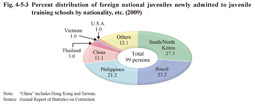2 Treatment of foreign national juvenile delinquents
(1) Correction
Fig. 4-5-2 shows the percent distribution of foreign national juveniles detained in juvenile classification homes by nationality, etc. in 2009 and Fig. 4-5-3 the percent distribution of foreign national juveniles newly admitted to juvenile training schools by nationality, etc. in 2009.
Fig. 4-5-2 Percent distribution of foreign national juveniles detained in juvenile classification homes by nationality, etc. (2009)
Fig. 4-5-3 Percent distribution of foreign national juveniles newly admitted to juvenile training schools by nationality, etc. (2009)
Treatment courses (See (1) c. of Subsection 2, Section 4, Chapter 2) available for use at juvenile training schools include the living guidance course G2, which was established in 1993 to cope with the increasing number of foreign national juveniles needing to be accommodated in juvenile training schools. Foreign national juveniles who need different treatment from that of Japanese juveniles are dealt with using the living guidance course G2 and provided with guidance on Japanese-language acquisition and the basic life style required in living in Japan with consideration given to whether they will remain in Japan or not after being discharged.
(2) Probation/parole Supervision
The number of foreign national juvenile probationers (excluding those placed under short-term probation for traffic offenses; hereinafter the same in this subsection) and juvenile training school parolees newly placed under probation/parole supervision in 2009 was 402 (306 juveniles probationers, 96 juvenile training school parolees), down 5.6% from the previous year. By nationality, etc., those from South/North Korea were the largest in number at 124, followed by Brazil at 107, the Philippines at 60, China (including Hong Kong and Taiwan) at 45, and Peru at 24 (See Appendix 3-6).
As of the end of 2009 the number of foreign national juveniles (excluding permanent residents and special permanent residents) placed under probation/parole supervision was 159 juvenile probationers and 65 juvenile training school parolees (Source: The Rehabilitation Bureau, Ministry of Justice).

